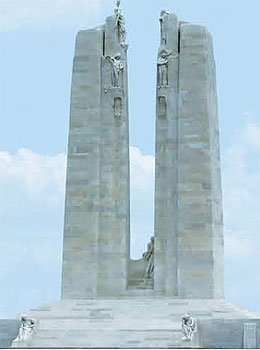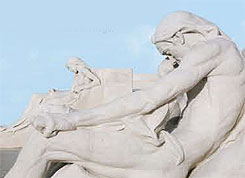Introduction
Canada's most impressive tribute overseas to those Canadians who fought and gave their lives in the First World War is the majestic and inspiring Canadian National Vimy Memorial which overlooks the Douai Plain from the highest point of Vimy Ridge, about ten kilometres north of Arras. The Memorial does more than mark the site of the engagement that Canadians were to remember with more pride than any other operation of the First World War. It stands as a tribute to all who served their country in battle in that four-year struggle and particularly to those who gave their lives. At the base of the Memorial, these words appear in French and in English:

Designed by Canadian sculptor and architect Walter Seymour Allward, the monument took eleven years to build. It rests on a bed of 11,000 tonnes of concrete, reinforced with hundreds of tonnes of steel. The towering pylons and sculptured figures contain almost 6,000 tonnes of limestone brought to the site from an abandoned Roman quarry on the Adriatic Sea (in present day Croatia). The figures were carved where they now stand from huge blocks of this stone. A cloaked figure stands at the front, or east side, of the monument overlooking the Douai Plain. It was carved from a single, 30-tonne block and is the largest piece in the monument. This sorrowing figure of a woman represents Canada—a young nation mourning her dead. Below is a tomb, draped in laurel branches and bearing a helmet and sword.

As an important cultural resource located on a significant historic site, the restoration of the Canadian National Vimy Memorial raised serious conservation issues and presented unique technical challenges. The history of the monument’s construction and the vision of its creator guided the restoration team in carrying out the work with particular care and craftsmanship. Construction and restoration of the Canadian National Vimy Memorial took place over a two-year period and was completed in 2007. The work included dismantling and rebuilding stone structures in the monument’s platform and vertical walls, replacing and re-engraving damaged stone, repointing the two massive pylons, cleaning the twenty statues that adorn the monument, and improving the drainage and lighting systems.

To the valour of their Countrymen in the Great War And in memory of their sixty Thousand dead this monument Is raised by the people of Canada
Carved on the walls of the monument are the names of 11,285 Canadian soldiers who were killed in France and whose final resting place was then unknown. Standing on the monument’s wide stone terrace overlooking the broad fields and rolling hills of Northern France, one can see other places where Canadians fought and died. More than 7,000 are buried in 30 war cemeteries within a 20-kilometre radius of the Canadian National Vimy Memorial. Altogether, more than 66,000 Canadian service personnel died in the First World War.
Directions
The Vimy Ridge National Historic Site Site is about 10 km north of Arras, 15 km south of Lens, 135 km southeast of Calais, and 175 km north of Paris.
Travelling without a car
If you are travelling without a car, we recommend that you first take the train to Arras. For information concerning train schedules, please visit the French National Railway Company (Société Nationale des Chemins de Fer [ SNCF]) web site. From Arras, you can travel to the Memorial by taxi ($50-$60 round trip).
To contact the Arras Tourism Office:
Telephone: 03 21 51 26 95 (calling from France); 011 333 2151 2695 (calling from Canada)
Email: contact@explorearras.com
Web site: Arras Tourism Office
Note: Although it may be indicated that trains go to Vimy, this is the village of Vimy and not the Canadian National Vimy Memorial. The Memorial is about 6 km away from the Vimy train station and there is no public transportation available there.
Travelling by car
If you are traveling by car, please follow the directions below:
Speed limits in France are 50 km/h within town limits and residential areas (generally unmarked), usually 90 km/h on secondary roads (but it may vary in areas) and 130 km/h on the motorway.
From Paris or Charles de Gaulle Airport
Take the A1 motorway, direction Lille, for about 160 km, then take the A26 towards Calais and drive for approximately 10 km. Take exit 7, direction Lens, on the N17 and drive for about 2 km. After passing through the village of Thélus, there will be three signs indicating to turn left at the next intersection to 1) the Forêt Domaniale, 2) the Mémorial canadien and, 3) the Canadian National Vimy Memorial, which is a large black sign with the Canadian flag. All three turn-offs are for the same road that leads to the commemorative site. Turn left towards the wood at the intersection. From Paris, it should take you approximately 2 to 2.5 hours to reach the site.
From Arras
Take the N17, direction Lens and drive for about 10 km. After passing through the village of Thélus, there will be three signs indicating to turn left at the next intersection to 1) the Forêt Domaniale, 2) the Mémorial canadien and, 3) the Canadian National Vimy Memorial, which is a large black sign with the Canadian flag. All three turn-offs are for the same road that leads to the commemorative site. Turn left towards the wood at the intersection. From Arras, it should take you approximately 15 minutes to reach the site.
From Calais
Take the A26 and continue on this road for approximately 130 km. Take exit 7, direction Lens, on the N17 and drive for about 2 km. After passing through the village of Thélus, there will be three signs indicating to turn left at the next intersection to 1) the Forêt Domaniale, 2) the Mémorial canadien and, 3) the Canadian National Vimy Memorial, which is a large black sign with the Canadian flag. All three turn-offs are for the same road that leads to the commemorative site. Turn left towards the wood at the intersection. From Calais, it should take you approximately 1.5 hours to reach the site.
From Lille
Take the A1 motorway, direction Paris. Continue on this road for approximately 45 km. Take the A26, direction Calais, and continue on this road for approximately 15 km. Take exit 7, direction Lens, on the N17 and drive for about 2 km. After passing through the village of Thélus, there will be three signs indicating to turn left at the next intersection to 1) the Forêt Domaniale, 2) the Mémorial canadien and, 3) the Canadian National Vimy Memorial, which is a large black sign with the Canadian flag. All three turn-offs are for the same road that leads to the commemorative site. Turn left towards the wood at the intersection. From Lille, it should take you approximately 45 minutes to 1 hour to reach the site.
For more information about the restoration project, please visit Canadian Battlefields Memorials Committee.
Vimy Ridge National Historic Site of Canada
62580 VIMY, FRANCE
Telephone: 03 21 50 68 68
Fax: 03 21 58 58 34
E-mail: vimy.memorial@vac-acc.gc.ca
- Date modified: